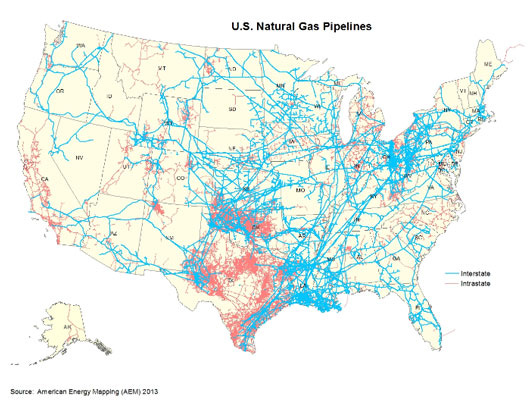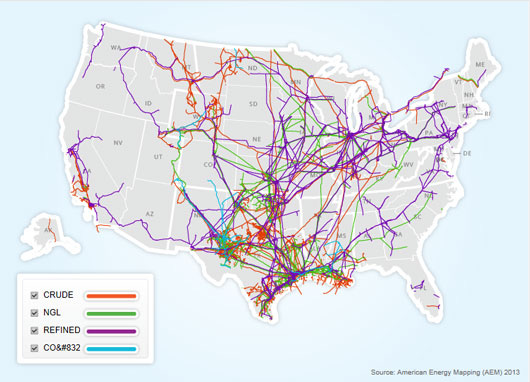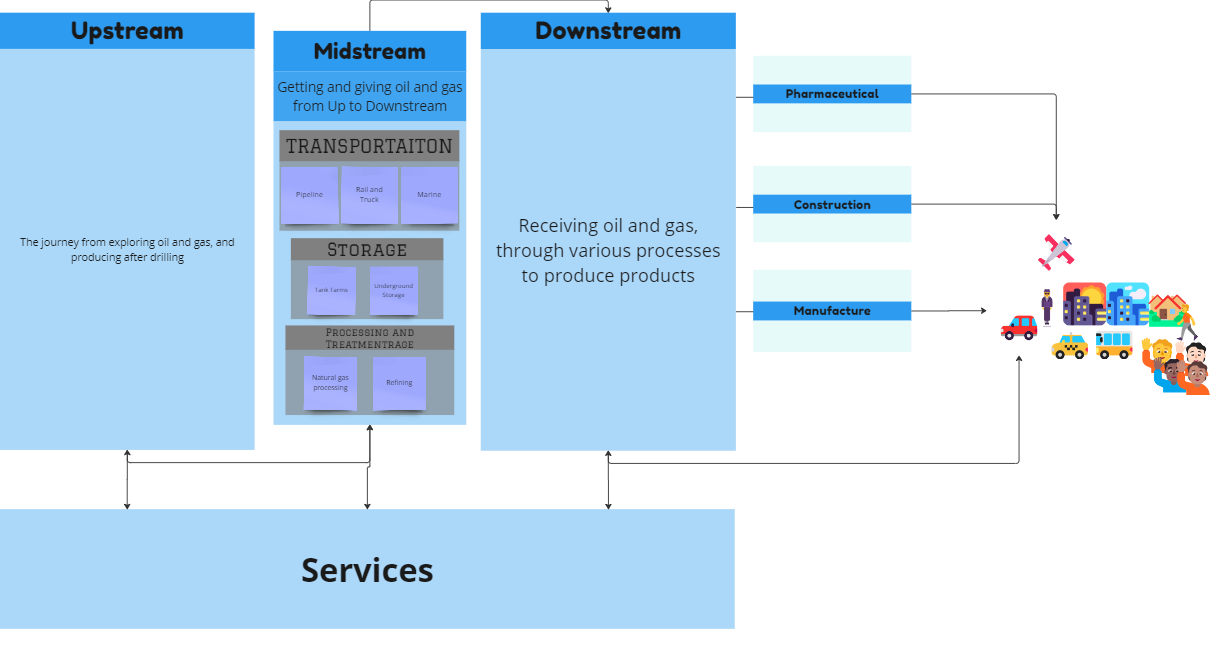Demystifying Oil & Gas Ecosystem: Midstream
An undervalued but undoubtedly crucial industry. This article sheds some light on the most underrated phase of oil and gas, the golden bridge. Risky but crucial to invest and innovate.
Energy has been at the center of all attention, from government to society, from big firms to small startups. Currently, the dominant source of energy is the oil and gas industry (virtually one-third). The demand has been rising, and the industry is responsible for balancing the supply, though other energy sources suffer from immaturity and unscalable technologies (but heavily invested to solve the challenge). On the other hand, not only is it used for energy, but also for almost all things we need on a daily basis, our smartphones, our drugs, etc.
As discussed in the previous article (Demystifying Oil & Gas Ecosystem: Upstream), the O&G industry has four main sectors, including Upstream, Midstream, Downstream, and Services. I explained the ingredients of the upstream segment what makes it important and some examples of businesses, and now I would like to discuss the Midstream sector in this story.
Midstream
This segment acts as the bridge to transport hydrocarbon from Upstream to Downstream, in order to provide input for businesses or direct customers. Though this sector seems less important and small compared to the two other sectors, it is actually vital; as a simple and meager disruption in transportation would cause devastating effects, including environmental pollution or a shortage and crisis (USA in 1970s).
In this segment, players are responsible for a few tasks, including transporting, storing, and, processing & treating the hydrocarbon. The following explain these stages:
Transportation
The heart of this section is, moving hydrocarbons as efficiently as possible from production facilities (upstream) to refinery facilities or alternatives (downstream).
We usually have only oil or gas, or a blend (sometimes water can be produced as well), and according to the mixture whether it is only one-phase or two-phase liquid. We transport through via the following means:
Pipeline Infrastructure
Pipelines are one of the safest ways to transport energy and are already the dominant one for long-distance transportation. United States has the 65% of the pie in the world, in 2013.
Transporting natural gas with pipelines is more challenging than crude oil as it has to retain high pressure throughout the pipeline.
As you can see the map of pipelines in the US:


Since pipeline transportation is the dominant and most secure way, it has created an enormous opportunity for businesses to focus on the following:
INGU🇨🇦 uses AI to give the opportunity to inspect pipelines for deposits and leaks while the operation is going on. Strohm, formerly Airborne Oil & Gas, offers Thermoplastic Composition Pipe, as a superior pipeline with zero failures (at least they claim).
orbital Sidekick🇺🇸 offers to identify GHG emissions and potential pipeline leaks by monitoring pipeline systems with satellites.
AVEVA🇬🇧 offers leak detection solutions, digital safety management solutions, operator training systems, etc. for midstream pipelines.
Hifi🇨🇦 offers avoiding pipeline leak detection by using fiber optic sensing and machine learning.
Rail and Trucking
Trains are used to transport hydrocarbon or its products to locations where there is no pipeline infrastructure or fields where production exceeds pipeline capacity.
On the other hand, Trucks are used to transport to short-distance and inaccessible areas that need less quantities of hydrocarbon or products.
Marine Transportation
About one-third of global marine trade constructs for oil and gas, consisting of oil and gas transportation across oceans and seas for international trades or for inland waterways that lack pipelines.
Storage
Storing oil and gas could stem from various reasons by corporations and governments. As shutting down the production wells is not economically feasible, or in times of low demand companies just lower the supply instead of production and store the surplus hydrocarbons, and vice versa, increasing production when the demand has suddenly skyrocketed.
On the other hand, governments might have a different agenda for storing hydrocarbons such as the US government having a “U.S. Strategic Petroleum Reserve (SPR)” for times of need or crisis (like the oil and gas crisis in the 1970s).
Storing the oil could be done in two forms:
Tank Farms
a collection of numerous tanks to store oil and its product, also called oil depots or oil terminals.
Underground Storage
storing hydrocarbon underground, especially gas due to certain pressure requirements. This type of storage could be beneficial during periods of high demand.
Processing and Treatment
some description
Natural gas processing
Facilities designed to clean raw natural gas by separating the gas, basically to remove hazardous materials.
Refining
The process of transforming crude oil into various materials for various applications, like jet fuels.
Edgewater Midstream 🇺🇸 is one of the businesses active in this section that gives midstream solutions to refiners, producers, and marketers of crude oil, and refined products.
Terminal Facilities
We have three terminals to load hydrocarbon or its derivatives to import, export, and distribute: Export Terminals, Import Terminals, and Distribution Terminals
On the other hand, to connect these terminals we could transport in three ways:
Gathering (production processing pad to mainline - from well surface to the pipeline)
Mainline (moving oil and gas to refineries, export terminals, etc.)
Distribution (limited for oil but extensively for natural gas)
Regulation and Safety
Regulatory Compliance
The midstream sector is highly regulated due to various reasons, especially environmental pollution. Federal Energy Regulatory Commission (FERC), as the main body of agency, with a number of other agencies are responsible for regulating the O&G industry.
Environmental Conservation
There are some potential hazards from the oil industry, including the possibility of fire and explosion anytime, oil leakage while transportation (onshore and offshore), using and leaking of some harmful chemicals to the environment, producing CO2 (which has caused global warming), etc.
Encino Environmental🇺🇸 works in environmental testing services providing emissions monitoring, detection, quantification, and mitigation.
LongPath Technologies🇺🇸 uses 360-degree high-frequency lasers to offer continuous, quantitative methane emissions monitoring for operators across the oil and gas supply chain.
DroneDeploy🇺🇸 offers automation of reality capturing using AI to monitor aerial and ground views of construction progress to automated gauge readings and methane leak detection.
Where do opportunities lie:
There’s no doubt that we can find opportunities by advancing and digitalizing the current workflows or empowering them more environmentally friendly. The obvious and current focus of entrepreneurs and industry leaders is more on pipelines.
However, on the other hand, entrepreneurs can see this market as a less exploited market. I mean, it hasn’t seen that revolutionary breakthrough as we’ve seen in tech. Here contrary thinking might be helpful: When a lot of people are not concentrated in a particular area, probably there’s some juice to be squeezed and of course, the juice is worth the squeeze.
On top of all, there’s no real competition. It’s just the big companies and a number of small companies that could only earn money more through their network than their proprietary technology. There is a potential for disruptive startups to rephrase the story of the market, to change whatever has been for decades. There is a chance to build a new market, an unseen market.
The industry is not just about energy, it is the feed of our industrialized civilization. Almost our daily life is dependent somehow on oil and gas or its by-products.
There’s been a new wave of technological startups in the market such as :
Context Labs🇺🇸 has created a data platform to ingest environmental and pipeline data from a multitude of sources and certificate carbon intensities for delivery pathways, from the wellhead to the end use for the molecule.
PetroDE🇺🇸 helps companies with their decision-making by analyzing and visualizing data in real time.
This was a general overview of the midstream oil and gas industry, with some examples of active companies. Please note that this is not a sponsored or advertising article and mentioning some names was just to show what others commercially do.
If you know other startups please comment and let others know, if you are a founder, executive, investor, etc., and liked the article, I’d like to hear your opinions, so feel free to hit me up on LinkedIn or Twitter.
References:
API | Rail Transportation Today
Transporting Oil by Sea | Planète Énergies (planete-energies.com)
API | Maritime Safety & Efficiency
Storage - Oil and Gas Industry: A Research Guide - Research Guides at Library of Congress (loc.gov)
Terminals (Midstream) (glamox.com)
1957-Underground_Storage_for_Petroleum.pdf (energy.gov)
The Basics of Underground Natural Gas Storage - U.S. Energy Information Administration (eia.gov)
PHMSA: Stakeholder Communications - NG Processing Plants (dot.gov)
Refining crude oil - the refining process - U.S. Energy Information Administration (EIA)




